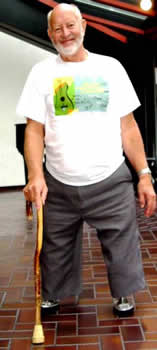Last updated 01/2008 | Download PDF
INTRODUCTION

Moreover, the difficulties present during ambulatory rehabilitation are twofold for the bilateral above-knee amputee (BAKs). Because of the loss of knee function, only the strongest and most determined BAKs can expect to regain ambulatory control when using conventional bilateral leg prostheses.2 Studies show that most BAKs find prosthetic walking to be overtly stressful, physically draining, and for some impracticable, particularly among the elderly and physically unfit, who choose a wheelchair as the preferred mode of transportation, hopeful that this will alleviate all or a portion of these dilemmas. In some cases this is true; however, there is another prosthetic possibility, one that is more energy efficient and less physically demanding, and one that most bilateral leg amputees will have already experienced during the initial stages of ambulatory rehabilitation: stubbies.3
WHAT ARE STUBBIES?
Stubbies are foreshortened prostheses used during and sometimes after initial ambulatory rehabilitation. They are custom fitted and are usually made up of standard sockets, no articulated knee joints or shank, with modified rocker bottoms or Sach feet turned backward to prevent the individual from falling4. This design allows the bilateral leg amputee to achieve a lower center of gravity for better balance and stability. Pylons and/or knee adapters can be added to the setup depending on the individual’s desired height and/or motion, and suspension is achieved through the use of waist bands and/or suspenders. Stubbies are relatively easy to use and, though restrictive in their range of ambulation, allow for relative ease of locomotion with less energy cost to the amputee. In fact, using stubbies can reduce heart rate and oxygen use by 7 to 23 percent and can increase walking speed by up to 25 percent.5They are particularly helpful in the early stages of rehabilitation, since they can help to prevent contracture and/or abduction and promote healing in the residual limb. Although stubbies are generally used as training devices to determine an amputee’s ability to move to a standard, full-length prosthesis, they are also used daily by amputees across the world.6
WHO CAN BENEFIT?
All bilateral leg amputees can greatly benefit from the use of stubbies during and after initial ambulatory rehabilitation, especially those with short residual limbs. The elderly, physically unfit, diabetic, and/or those affected by vascular and/or cardiorespiratory conditions are also prime candidates for fitting. They can be beneficial to children as well, providing rehabilitative advantages during adolescence and saving parents the trouble of fitting the child with a new set of prostheses every time a growth spurt occurs. Although some will find the acute reduction in height and the resulting ambulation less than cosmetically appealing, others will find that they are more interested in getting on with their lives.7
POINTS TO REMEMBER…
- During initial ambulatory rehabilitation, stubbies can help the amputee attain the sense of balance and stability needed to even consider trying to walk with conventional prostheses (which usually gives amputees the feeling they are standing on stilts). Remember, however, that lengthening the stubby, or changing to a conventional prosthesis, greatly increases the amount of balance and energy required for ambulation.
- If possible, bilateral above-knee amputations at the thigh are preferred over hip disarticulations, since they permit better sitting ability and can alleviate problems associated with moving from the prostheses to a wheelchair.8
- Although certain limitations are associated with using stubbies (negotiating ramps, stairs, etc.), some obstacles can be surmounted with the combination of other assistive devices (braces, canes, crutches, etc.).
- It is recommended that all individuals with bilateral leg amputations have permanent access to a wheelchair.
1 A. Wilson Bennett, Jr., A Primer on Limb Prosthetics (Springfield: Charles C. Thomas Publishing, 1998) 76-8.
2 A. Wilson Bennett, Jr., Limb Prosthetics, 6 th ed. (New York: Demos Publications, 1989) 64-7.
3 Yi-Jane Wu et al, “Energy Expenditure of Wheeling and Walking During Prosthetic Rehabilitation in a Woman With Bilateral Transfemoral Amputations,” Archives of Physical Medicine and Rehabilitation 82 (2001): 265-69.
4 Susan B. O’Sullivan and Thomas J. Schmitz, Physical Rehabilitation: Assessment and Treatment, 3 rd ed. (Philadelphia: F.A. Davis Company, 1994) 392.
5 A. Gitter et al, “Influence of Rotators on the Kinematic Adaptations in Stubby Prosthetic Gait,” American Journal of Physical Medicine and Rehabilitation 81 (2002): 311.
6 Gitter 310.
7 Nancy Carroll, “Just a Cowboy at Heart,” inMotion, November/December 2002, 31.
8 Gloria T. Sanders, Lower Limb Amputations: A Guide to Rehabilitation (Philadelphia: F.A. Davis Company, 1986) 406-07.
It is not the intention of the Amputee Coalition to provide specific medical or legal advice but rather to provide consumers with information to better understand their health and healthcare issues. The Amputee Coalition does not endorse any specific treatment, technology, company, service or device. Consumers are urged to consult with their healthcare providers for specific medical advice or before making any purchasing decisions involving their care.
© Amputee Coalition. Local reproduction for use by Amputee Coalition constituents is permitted as long as this copyright information is included. Organizations or individuals wishing to reprint this article in other publications, including other websites must contact the Amputee Coalition for permission to do so, by emailing a request to rc@amputee-coalition.org.



